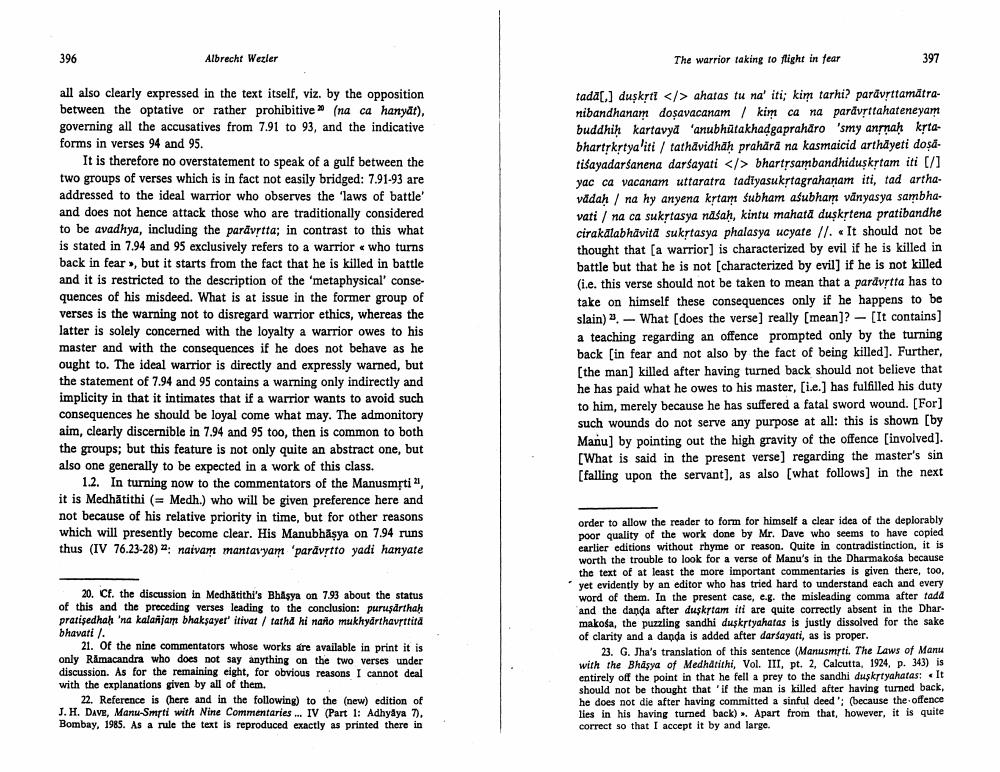________________
396
Albrecht Wezler
The warrior taking to fight in fear
397
all also clearly expressed in the text itself, viz. by the opposition between the optative or rather prohibitive (na ca hanydt), governing all the accusatives from 7.91 to 93, and the indicative forms in verses 94 and 95.
It is therefore no overstatement to speak of a gulf between the two groups of verses which is in fact not easily bridged: 7.91-93 are addressed to the ideal warrior who observes the laws of battle and does not hence attack those who are traditionally considered to be avadhya, including the paravrtta; in contrast to this what is stated in 7.94 and 95 exclusively refers to a warrior who turns back in fear, but it starts from the fact that he is killed in battle and it is restricted to the description of the 'metaphysical' consequences of his misdeed. What is at issue in the former group of verses is the warning not to disregard warrior ethics, whereas the latter is solely concerned with the loyalty a warrior owes to his master and with the consequences if he does not behave as he ought to. The ideal warrior is directly and expressly warned, but the statement of 7.94 and 95 contains a warning only indirectly and implicity in that it intimates that if a warrior wants to avoid such consequences he should be loyal come what may. The admonitory aim, clearly discernible in 7.94 and 95 too, then is common to both the groups; but this feature is not only quite an abstract one, but also one generally to be expected in a work of this class.
1.2. In turning now to the commentators of the Manusmrti", it is Medhatithi (= Medh.) who will be given preference here and not because of his relative priority in time, but for other reasons which will presently become clear. His Manubhāşya on 7.94 runs thus (IV 76.23-28) : naivam mantaryam 'pardvętto yadi hanyate
tadal.] dusktt </> ahatas tu na' iti; kim tarhi? pardvęttamatranibandhanart dosavacanam / kim ca na pardvęttahateneyat buddhih kartavyd 'anubhatakhadgapraharo "smy annah krtabhartykytya'iti/ tathāvidhah prahard na kasmaicid arthâyeti dosatifayadarsanena darsayati </> bhartssambandhiduşktam iti [/] yac ca vacanam uttaratra tadiyasukstagrahanam iti, tad arthavddah / na hy anyena kytam subham asubham vanyasya sambhavati na ca sukstasya nasah, kintu mahata duskytena pratibandhe cirakalabhävita sukytasya phalasya ucyate //. It should not be thought that [a warrior) is characterized by evil if he is killed in battle but that he is not [characterized by evil) if he is not killed (i.e. this verse should not be taken to mean that a pardurtta has to take on himself these consequences only if he happens to be slain) ”. - What [does the verse) really (mean]? - (It contains] a teaching regarding an offence prompted only by the turning back (in fear and not also by the fact of being killed). Further, [the man) killed after having turned back should not believe that he has paid what he owes to his master, [i.e.) has fulfilled his duty to him, merely because he has suffered a fatal sword wound. (For] such wounds do not serve any purpose at all: this is shown [by Manu) by pointing out the high gravity of the offence [involved]. [What is said in the present verse) regarding the master's sin [falling upon the servant), as also (what follows] in the next
20. Cf. the discussion in Medhatithi's Bhlsya on 793 about the status of this and the preceding verses leading to the conclusion: purusdrthah pratisedhah 'na kalajar bhaksayer'itivar / tatha hinarlo mukhydrthavrtita bhavari
21. Of the nine commentators whose works are available in print it is only Ramacandra who does not say anything on the two verses under discussion. As for the remaining eight, for obvious reasons I cannot deal with the explanations given by all of them.
22. Reference is (here and in the following) to the (new) edition of J.H. DAVE, Manu-Smrti with Nine Commentaries ... IV (Part 1: Adhyâya 7). Bombay, 1985. As a rule the text is reproduced exactly as printed there in
order to allow the reader to form for himself a clear idea of the deplorably poor quality of the work done by Mr. Dave who seems to have copied earlier editions without rhyme or reason. Quite in contradistinction, it is worth the trouble to look for a verse of Manu's in the Dharmakosa because the text of at least the more important commentaries is given there, too, yet evidently by an editor who has tried hard to understand each and every word of them. In the present case, eg the misleading comma after tada and the danda after duskrtam iti are quite correctly absent in the Dharmakosa, the puzzling sandhi duskrtyahatas is justly dissolved for the sake of clarity and a danda is added after darsayati, as is proper.
23. G. Jha's translation of this sentence (Manusmrti. The Laws of Manu with the Bhasya of Medharithi, Vol. III, pt. 2, Calcutta, 1924, p. 343) is entirely off the point in that he fell a prey to the sandhi duskreyahatas: . It should not be thought that if the man is killed after having turned back, he does not die after having committed a sinful deed': (because the offence lies in his having turned back). Apart from that, however, it is quite correct so that I accept it by and large.




